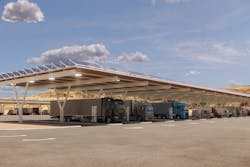TeraWatt plotting I-5 Trucking Electrification Charging corridor from Long Beach to El Paso
Fleet e-mobility firm TeraWatt Infrastructure reported that it is developing a network of centers for charging heavy-duty and medium-duty electric trucks moving cargo along Interstate 10.
I-10 runs west to the east from the Port of Long Beach—among the busiest in the world—all the way across the southern U.S. to Jacksonville, Florida. TeraWatt’s network initially would stretch from the port to El Paso, Texas, on the border with Mexico.
Port of Long Beach starts construction on $12.2M Microgrid for Command and Control Center
The nation’s transportation sector emits about 27 percent of carbon dioxide air pollution in the nation, according to federal data. Of that transportation segment, medium and heavy duty trucks account for about a fourth of emissions, while light-duty vehicles emit more than half of the sector’s CO2 pollution.
“Long-haul trucking electrification represents a significant opportunity to reduce transportation sector emissions, but hinges on the rapid scale up of specialized charging infrastructure,” said TeraWatt CEO Neha Palmer. “Our real estate and energy infrastructure development platform uniquely positions TeraWatt to solve the ‘charging problem’ for trucking operators, making freight electrification achievable within their operations.”
The I-10 Electric Corridor will consist of multiple facilities, called TeraWatt Charging Centers, that will be spread across California, Arizona, and New Mexico, according to the company release. TeraWatt Charging Centers will be purpose-built to serve heavy-duty and medium-duty electric fleets, featuring dozens of direct current (DC) fast chargers, pull-through charging stalls, on-site driver amenities, and reliable operations including resiliency generation and zero carbon electricity options.
Electric utilities and commercial fleet operators have expressed a desire to work with each other on decarbonizing the industry and developing reliable charging infrastructure to alleviate range fears. Some are moving forward with plans, but most are still in early stages of learning the other’s needs and challenges, if even to that point.
A study by the North American Council for Freight Efficiency notes that fleet electrification adoption has been small. Findings, however, indicate that the case for financial and environmental improvement of smaller electric trucks, such as cargo vans and terminal trucks, likely would be very positive. Energy costs would drop significantly, the NACFE report determined.
T&D World C&E on Fleet Electrification: The Dance is just Beginning
Making the case for long-haul, heavy-duty is more difficult due to issues of time to charge and length of miles between charges.
TeraWatt says it will offer greater detail later about its I-10 plan. The early details show that the TeraWatt Charging Centers along the corridor would be approximately 150 miles apart and less than one mile from the nearest highway exit.
The company also plans to have partnerships to help manage all operations related to charging infrastructure.
Fleet electrification proponents including many west coast utilities also are planning for a strongly linked charging infrastructure corridor on Interstate 5 which runs from southern California north to Washington state. Among those utilities support work to get I-5 E-corridor up and running by 2025 include Southern California Edison, Pacific Gas & Electric, Sacramento Municipal Utility District, Pacific Power, Portland General Electric, Seattle City Light and Puget Sound Energy, among others.
-- -- --
(Rod Walton, senior editor for EnergyTech, is a 14-year veteran of covering the energy industry both as a newspaper and trade journalist. He can be reached at [email protected]).
Follow us on Twitter @EnergyTechNews_ and @rodwaltonelp and on LinkedIn
About the Author
Rod Walton, EnergyTech Managing Editor
Managing Editor
For EnergyTech editorial inquiries, please contact Managing Editor Rod Walton at [email protected].
Rod Walton has spent 17 years covering the energy industry as a newspaper and trade journalist. He formerly was energy writer and business editor at the Tulsa World. Later, he spent six years covering the electricity power sector for Pennwell and Clarion Events. He joined Endeavor and EnergyTech in November 2021.
Walton earned his Bachelors degree in journalism from the University of Oklahoma. His career stops include the Moore American, Bartlesville Examiner-Enterprise, Wagoner Tribune and Tulsa World.
EnergyTech is focused on the mission critical and large-scale energy users and their sustainability and resiliency goals. These include the commercial and industrial sectors, as well as the military, universities, data centers and microgrids. The C&I sectors together account for close to 30 percent of greenhouse gas emissions in the U.S.
He was named Managing Editor for Microgrid Knowledge and EnergyTech starting July 1, 2023
Many large-scale energy users such as Fortune 500 companies, and mission-critical users such as military bases, universities, healthcare facilities, public safety and data centers, shifting their energy priorities to reach net-zero carbon goals within the coming decades. These include plans for renewable energy power purchase agreements, but also on-site resiliency projects such as microgrids, combined heat and power, rooftop solar, energy storage, digitalization and building efficiency upgrades.

